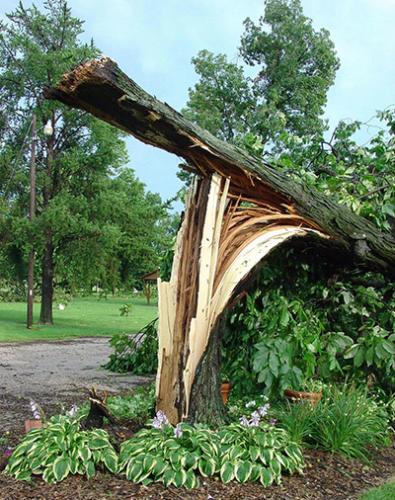Deciding which trees to save after a storm often requires careful inspection.
 Thunderstorms on Sunday night (Aug. 2, 2015) produced heavy wind
gusts, which resulted in widespread damage to trees throughout Lower
Michigan. Many homeowners are faced with downed or damaged trees and a
frequent question is what to do with storm-damaged trees. Damage to
trees following high winds and heavy rains can range from a few downed
limbs to complete up-rooting.
Thunderstorms on Sunday night (Aug. 2, 2015) produced heavy wind
gusts, which resulted in widespread damage to trees throughout Lower
Michigan. Many homeowners are faced with downed or damaged trees and a
frequent question is what to do with storm-damaged trees. Damage to
trees following high winds and heavy rains can range from a few downed
limbs to complete up-rooting.In some cases the decision of what to do with a damaged tree is obvious, but often the decision of whether to try to keep a tree can be difficult. When assessing storm damaged trees, Michigan State University Extension reminds homeowners:
- Safety first! Downed trees and large limbs are often unstable and can move or pivot unexpectedly. Look for hanging, broken limbs that can drop from overhead. If you are unsure if you can work around a tree safely or if a tree is near utilities, structures, cars or people, contact a professional arborist to ensure a safe removal. Professional arborists are specifically trained in tree inspection and removal. The International Society of Arboriculture has a “Find an Arborist” feature on its website or look for certified arborists in the yellow pages.
- Beware of “doorknockers.” Homeowners in storm-damaged areas may be approached by individuals offering to remove downed or damaged trees. Unlike professional arborists, these doorknockers do not have the specific training and expertise to work around dangerous trees or power lines and may not be insured.
- Tree damage often reflects pre-exiting tree problems. Limbs or trees that come down in thunderstorms often have underlying defects that caused them to fail. Some examples include fungal decay, previous damage or poor root structure. If a tree loses a limb during a storm because of decay, it’s possible other parts of the tree may have similar problems.
- Does the damage make the tree a future hazard? Trees that lose major limbs may become unstable and may become prone to fail in the next storm.
- Is the tree near any “targets?” In assessing hazardous trees, arborists look at targets – what will the tree or limb hit if it falls? Damaged trees located in native woodlots or windbreaks are likely to be less of a concern than a tree that overhangs a house or car-port.
- What is the overall condition of the tree? The National Arbor Day Foundation has an online illustrated a guide, Can these trees be saved?, that can help homeowners perform an initial assessment of their damaged trees.
 Large, downed trees can turn or pivot unexpectedly
and are best handled by a professional arborist. Photo: Jim Skiera,
International Society of Arboriculture, Bugwood.org
Large, downed trees can turn or pivot unexpectedly
and are best handled by a professional arborist. Photo: Jim Skiera,
International Society of Arboriculture, Bugwood.org
